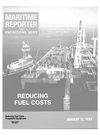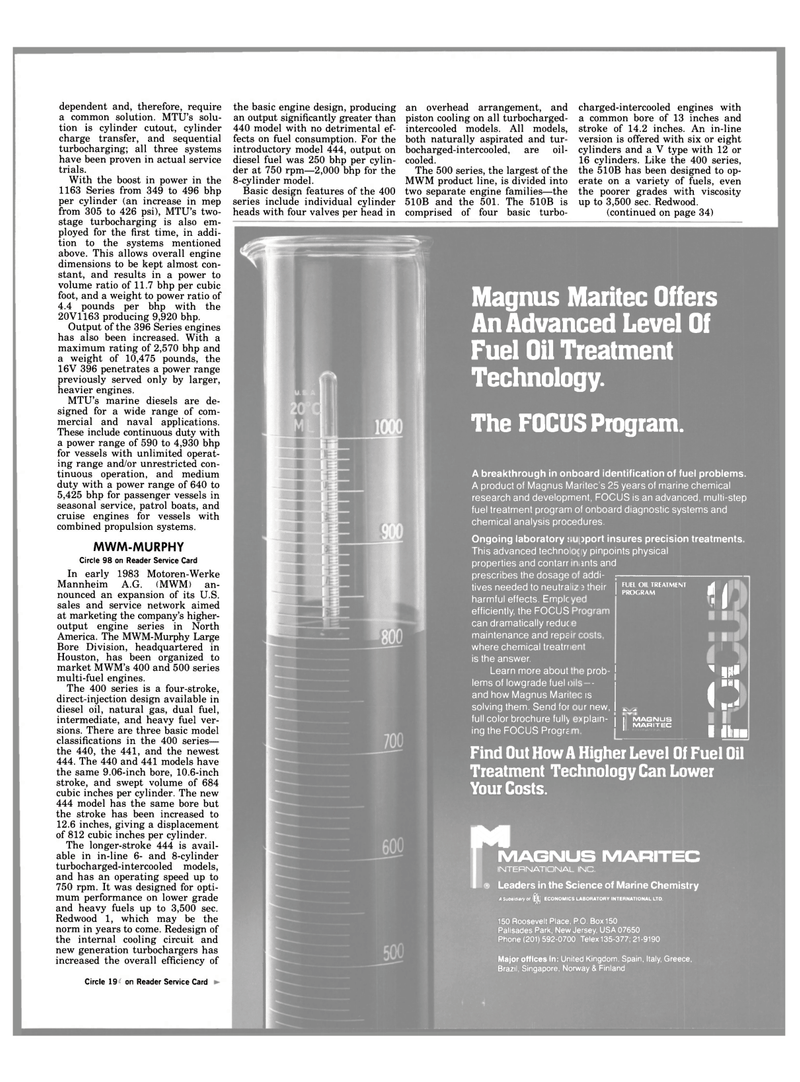
Page 31: of Maritime Reporter Magazine (January 15, 1984)
Read this page in Pdf, Flash or Html5 edition of January 15, 1984 Maritime Reporter Magazine
dependent and, therefore, require a common solution. MTU's solu- tion is cylinder cutout, cylinder charge transfer, and sequential turbocharging; all three systems have been proven in actual service trials.
With the boost in power in the 1163 Series from 349 to 496 bhp per cylinder (an increase in mep from 305 to 426 psi), MTU's two- stage turbocharging is also em- ployed for the first time, in addi- tion to the systems mentioned above. This allows overall engine dimensions to be kept almost con- stant, and results in a power to volume ratio of 11.7 bhp per cubic foot, and a weight to power ratio of 4.4 pounds per bhp with the 20V1163 producing 9,920 bhp.
Output of the 396 Series engines has also been increased. With a maximum rating of 2,570 bhp and a weight of 10,475 pounds, the 16V 396 penetrates a power range previously served only by larger, heavier engines.
MTU's marine diesels are de- signed for a wide range of com- mercial and naval applications.
These include continuous duty with a power range of 590 to 4,930 bhp for vessels with unlimited operat- ing range and/or unrestricted con- tinuous operation, and medium duty with a power range of 640 to 5,425 bhp for passenger vessels in seasonal service, patrol boats, and cruise engines for vessels with combined propulsion systems.
MWM-MURPHY
Circle 98 on Reader Service Card
In early 1983 Motoren-Werke
Mannheim A.G. (MWM) an- nounced an expansion of its U.S. sales and service network aimed at marketing the company's higher- output engine series in North
America. The MWM-Murphy Large
Bore Division, headquartered in
Houston, has been organized to market MWM's 400 and 500 series multi-fuel engines.
The 400 series is a four-stroke, direct-injection design available in diesel oil, natural gas, dual fuel, intermediate, and heavy fuel ver- sions. There are three basic model classifications in the 400 series— the 440, the 441, and the newest 444. The 440 and 441 models have the same 9.06-inch bore, 10.6-inch stroke, and swept volume of 684 cubic inches per cylinder. The new 444 model has the same bore but the stroke has been increased to 12.6 inches, giving a displacement of 812 cubic inches per cylinder.
The longer-stroke 444 is avail- able in in-line 6- and 8-cylinder turbocharged-intercooled models, and has an operating speed up to 750 rpm. It was designed for opti- mum performance on lower grade and heavy fuels up to 3,500 sec.
Redwood 1, which may be the norm in years to come. Redesign of the internal cooling circuit and new generation turbochargers has increased the overall efficiency of •* Circle 189 on Reader Service Card the basic engine design, producing an output significantly greater than 440 model with no detrimental ef- fects on fuel consumption. For the introductory model 444, output on diesel fuel was 250 bhp per cylin- der at 750 rpm—2,000 bhp for the 8-cylinder model.
Basic design features of the 400 series include individual cylinder heads with four valves per head in an overhead arrangement, and piston cooling on all turbocharged- intercooled models. All models, both naturally aspirated and tur- bocharged-intercooled, are oil- cooled.
The 500 series, the largest of the
MWM product line, is divided into two separate engine families—the 510B and the 501. The 510B is comprised of four basic turbo-
Ongoing laboratory;
This advanced techno properties and contarr prescribes the dosage tives needed to neutra harmful effects. Emplc efficiently, the FOCUS can dramatically reduc maintenance and repa where chemical treatrr is the answer.
Learn more about lems of lowgrade fuel < and how Magnus Mari solving them. Send for full color brochure fully ing the FOCUS Progre charged-intercooled engines with a common bore of 13 inches and stroke of 14.2 inches. An in-line version is offered with six or eight cylinders and a V type with 12 or 16 cylinders. Like the 400 series, the 510B has been designed to op- erate on a variety of fuels, even the poorer grades with viscosity up to 3,500 sec. Redwood. (continued on page 34) jport insures precision treatments iy pinpoints physical ints and addi- sthoir FUEL OIL TREATMENT 4 i -me'r PROGRAM I I ; I prob- ^ | I .. < ! mew, I plain- MAGNUS r MARITEC • i m
Magnus Maritec Offers
An Advanced Level Of
Fuel Oil Treatment
Technology.
The FOCUS Program.
A breakthrough in onboard identification of fuel problems.
A product of Magnus Maritec's 25 years of marine chemical research and development, FOCUS is an advanced, multi-step fuel treatment program of onboard diagnostic systems and chemical analysis procedures.
Find Out How A Higher Level Of Fuel Oil
Treatment Technology Can Lower
Your Costs. m
MAGNUS MARITEC
INTERNATIONAL INC.
Leaders in the Science of Marine Chemistry
ASuMidUiyof ijlj ECONOMICS LABORATORY INTERNATIONAL LTD. 150 Roosevelt Place, P.O. Box 150
Palisades Park, New Jersey, USA 07650
Phone (201) 592-0700 Telex 135-377; 21-9190
Major offices in: United Kingdom. Spain, Italy, Greece,
Brazil, Singapore, Norway & Finland

 30
30

 32
32
